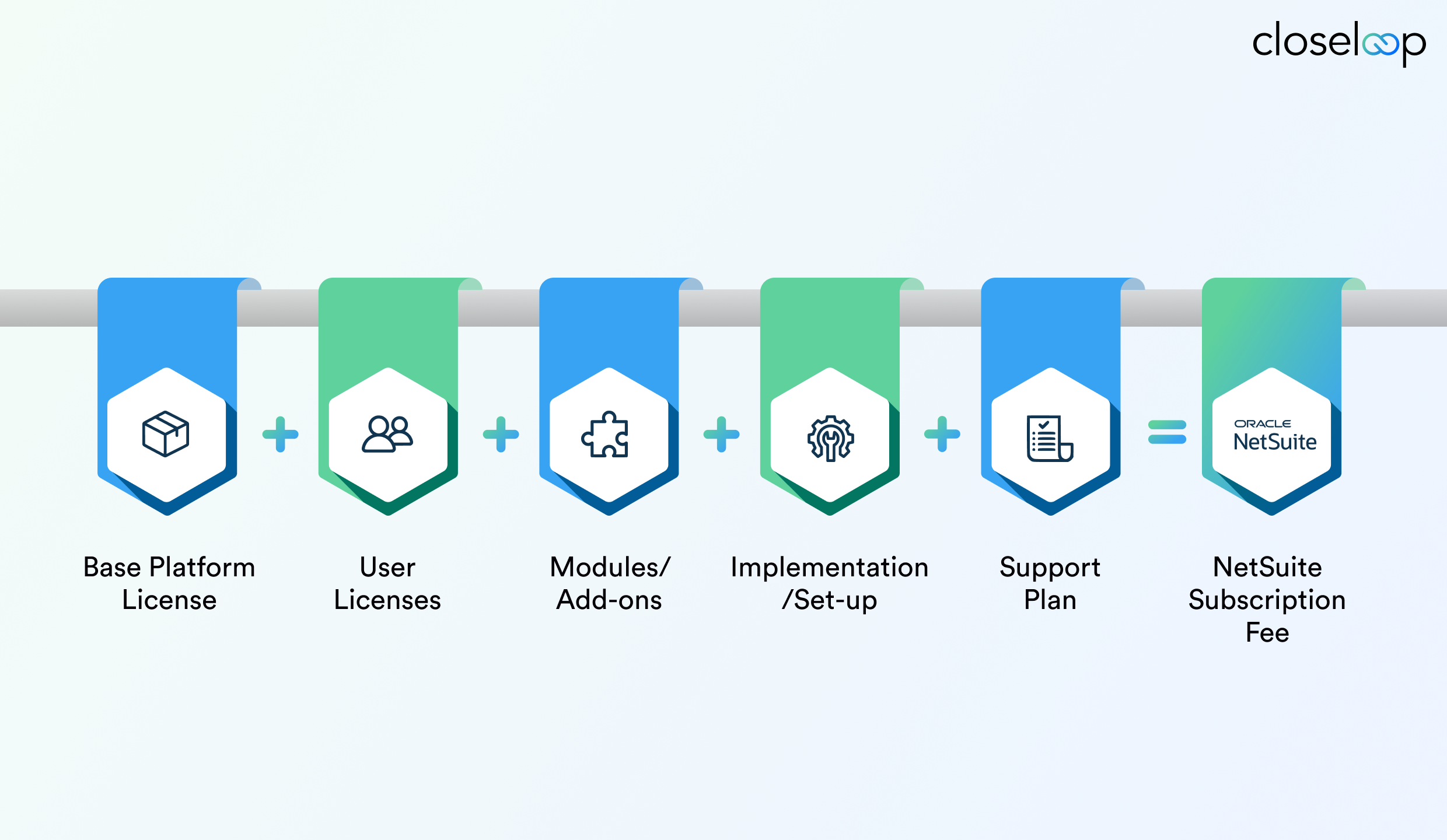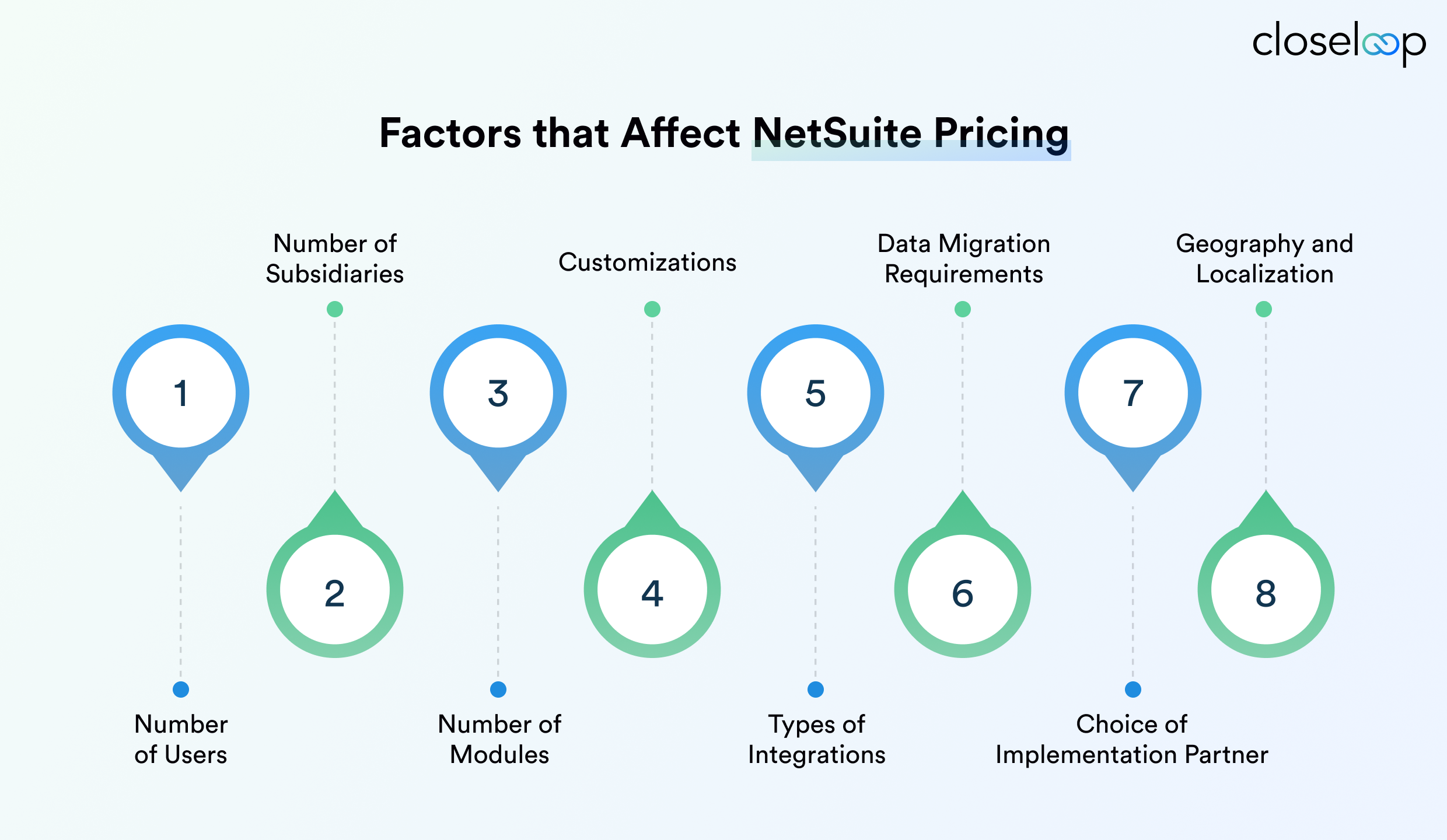NetSuite has become a go-to ERP for companies looking to unify their finance, operations, and commerce systems on a single cloud platform. But ask ten different NetSuite customers what they paid to get up and running, and you will likely hear ten different answers.
That’s not by accident. NetSuite’s pricing structure is built around modularity and customization, designed to adapt to a business. While this flexibility is valuable, it also means there’s no one-size-fits-all number when it comes to the cost of licensing, implementation, or ownership.
If you have already spent time searching for Oracle NetSuite pricing online, you have probably noticed the absence of fixed rates or a transparent pricing table. That’s because your total cost depends on several interlocking factors like the modules you need, how many users you plan to onboard, the complexity of your workflows, the number of subsidiaries or legal entities in your business structure, and whether you are going through Oracle directly or working with a NetSuite implementation partner.
It is also shaped by your industry, meaning NetSuite implementation in wholesale distribution looks very different from those in SaaS or professional services. This means budgeting for NetSuite requires a complete understanding of what drives both upfront and ongoing costs.
In fact, most implementations cost 3-4 times more than what was initially budgeted, largely due to unclear scope, underplanned integrations, or unexpected module requirements post-purchase. This makes it even more important to understand how pricing actually works before engaging in vendor discussions or sending out an RFP.
This guide will walk you through every layer of NetSuite pricing, from licensing tiers and user types to module add-ons, implementation cost ranges, and the long-term expenses that don’t always show up in the initial quote. We will break down what you are paying for, where the flexibility lies, and how to avoid buying more than you actually need.
We will also cover how NetSuite compares to other ERP platforms in terms of total cost of ownership and how to approach the quote process if you are ready to speak to a solution provider. By the end, you should have a clearer picture of what NetSuite might cost your business and what factors will shape that number.
How NetSuite Pricing Works: Core Components Explained
As a buyer, one of the first things you will notice about NetSuite is how little public pricing is available. Unlike SaaS platforms that offer tiered monthly plans, NetSuite uses a modular architecture and a subscription-based model.
Understanding how NetSuite pricing works requires breaking it into its main
components. The total cost of ownership (TCO) includes more than just the
software license. There are platform fees, user licenses, advanced modules,
and implementation services to consider, each of which contributes to your
final number.
Base Platform License
Every NetSuite account starts with a base platform license. This is the foundation of your system and includes access to core ERP functionality, including general ledger, accounts payable and receivable, basic inventory, order management, and reporting.
As of 2025, the starting cost for a base license is approximately $999 per month, billed annually. This gives your company access to the main ERP infrastructure but excludes users or any specialized modules. It is a prerequisite for every NetSuite customer and functions like the “entry ticket” into the ecosystem.
The base license is also scaled depending on the size of your company. If you are a small business with one entity, you may be quoted on the lower end. If you are a global organization with complex accounting and compliance requirements, expect the platform fee to be significantly higher.
|
Thinking of switching from legacy systems to NetSuite? This migration guide for C-level leaders breaks down what to plan for before the first invoice. |
User Licenses
In addition to the platform license, NetSuite pricing includes named user licenses. These are assigned to individuals who need access to the system. Pricing typically starts at around $99 per user per month, though this can vary based on the type of access each user requires.
There are two primary categories:
-
Full access users: Employees in finance, operations, sales, or IT who need to interact deeply with NetSuite’s backend like entering transactions, running reports, managing inventory, etc.
-
Employee self-service users: Team members who only need limited functionality, such as entering timesheets, viewing payslips, or submitting expense reports.
Only full users are counted in the standard per-user pricing. Self-service roles are significantly less expensive and often bundled at discounted rates.
Sandbox Environment
For companies that need a safe space to test configurations, customizations, or integrations without impacting live data, NetSuite offers Sandbox accounts. These are separate environments that mirror your production instance and are especially useful during development or major system changes.
Sandbox environments are not included by default and are priced as add-ons. The cost depends on your license tier and how many environments you need (e.g., Standard Sandbox vs. Development Sandbox). Most mid-sized companies should expect to pay several thousand dollars annually per sandbox.
Advanced Modules and Add-Ons
This is where NetSuite becomes truly customizable. Beyond the core ERP, Oracle offers a wide range of advanced modules that you can license based on your operational needs. These modules are priced individually and added to your subscription based on your requirements.
Some of the most common modules include:
-
Advanced Financials – For budgeting, allocations, and expense management
-
Inventory Management and WMS – For businesses handling complex logistics
-
SuiteBilling – Subscription billing, invoicing, and recurring revenue management
-
Revenue Recognition – Particularly important for ASC 606 compliance in SaaS and services
-
Project Management (SuiteProjects) – Time tracking, resource planning, and project billing
-
CRM – For companies that want to unify sales and customer data on the same platform
Each module typically costs $300 to $1,500+ per month, depending on functionality, scale, and user access. Some industries require multiple modules out of the gate, while others can start small and expand as needed.
It’s worth noting that many of these modules are industry-specific. A wholesale distributor might need robust inventory and warehouse management tools, while a software company may prioritize revenue recognition and subscription billing. The flexibility is powerful, but it is also where costs start to escalate.
|
Want to know how NetSuite is evolving with AI and automation? Explore the latest NetSuite AI-powered features and what they mean for your ERP roadmap. |
SuiteSuccess Editions (Pre-Built Bundles)
Oracle has packaged industry-specific NetSuite editions under the SuiteSuccess umbrella. These bundles include a predefined set of modules, dashboards, KPIs, and workflows tailored for different verticals like manufacturing, professional services, nonprofit, and retail.
SuiteSuccess is marketed as a faster, more predictable way to implement NetSuite. Pricing for these editions varies, but can simplify the license + module selection process. While they don’t necessarily cost less, they reduce configuration time and align NetSuite’s features with industry best practices.
Keep in mind that SuiteSuccess is still modular. Though you can add or remove functionality, doing so will affect pricing.
Implementation and Setup Costs (One-Time Fees)
NetSuite licensing does not include implementation. So if you are working with Oracle’s own delivery team or a NetSuite partner like Closeloop, implementation is scoped and priced separately. These one-time costs are based on:
-
Process discovery and system design
-
Workflow and script customization
-
3rd-party system integrations (e.g., Salesforce, Shopify)
-
Training, documentation, and go-live support
While this will be covered in more detail in the next section, it is important to understand that implementation is not optional and can range from $25,000 to $150,000 or more, depending on the complexity of your requirements.
|
Using Salesforce alongside NetSuite? Here’s a practical guide to NetSuite Salesforce integration, without creating data silos or duplicate processes. |
Annual Renewal and Support Plans
NetSuite licenses are typically contracted for one year and must be renewed annually. Oracle usually enforces a minimum contract size, often $10,000–$15,000/year. Pricing can increase at the time of renewal, especially if your user count or modules have expanded. Some customers negotiate multi-year agreements to lock in rates.
Support is another factor. NetSuite offers Basic, Premium, and Advanced Support tiers. Basic support is included, but Premium support, which includes faster response times and 24/7 coverage, comes at an additional cost.
What You Are Really Paying For
A midsize company with five full users, three advanced modules, and basic financials might expect a starting price of $3,000 to $4,000 per month in licensing alone. Add NetSuite integration and implementation, and your first-year ERP cost could be between $50,000 and $100,000+.
That number might seem steep until you compare it to running multiple disconnected systems, managing manual workflows, or using legacy ERPs that require expensive upgrades every few years. NetSuite’s value is in its adaptability, but to budget accurately, you need to know exactly what components are involved.
NetSuite Pricing Breakdown 2025: Quick recap
|
Component |
Description |
Estimated Cost (USD) |
|
Base Platform License |
Core ERP functionality (GL, AR/AP, basic reporting) |
Starting at $999/month |
|
User Licenses |
Named user access (finance, ops, sales, admin) |
$99–$149/user/month |
|
Advanced Modules |
Functional add-ons (e.g., WMS, Rev Rec, SuiteBilling, Projects) |
$300–$1,500+/module/month |
|
SuiteSuccess Bundles |
Industry-focused editions with prebuilt KPIs and workflows |
Varies by edition – bundled pricing |
|
Implementation Costs |
One-time setup, data migration, config, testing, and go-live support |
$25,000–$150,000+ (project-based) |
|
Support Plans |
Basic support included; Premium adds 24/7 access and faster SLAs |
Premium: ~20%+ of license fees annually |
|
Annual Renewal |
License renewal with possible cost increase |
Varies; renegotiated annually or multi-year lock |
What Factors Influence NetSuite Cost?
Two companies of similar size can receive vastly different quotes based on how they plan to use the platform. That’s because NetSuite pricing is not just based on headcount or annual revenue. It reflects how deeply the system will be embedded in your operations, how many moving parts it needs to support, and how much customization is involved.
Below are the primary factors that shape your total NetSuite cost, including
both licensing and implementation expenses.
Number of Users and Their Roles
NetSuite uses a named user licensing model, as explained above, meaning each person who needs full access to the system requires an individual license. You will also need to consider whether any employees can be categorized under “self-service” roles, which are much cheaper and typically used for submitting timesheets, expense claims, or viewing pay stubs.
Before committing to a license count, it is smart to conduct a role mapping exercise to determine who really needs full access. Over-licensing is a common source of wasted spend in NetSuite deployments.
Number of Legal Entities or Subsidiaries
NetSuite was designed with multi-entity businesses in mind. Its OneWorld functionality allows companies to manage multiple subsidiaries, business units, and currencies within a single instance. However, adding more subsidiaries increases configuration scope and may raise base license tier.
If your organization operates across multiple countries or maintains distinct brands with separate accounting rules, you will need OneWorld enabled, and possibly additional configuration or localization support. This often increases the base platform fee and adds more depth to the implementation scope.
Modules and Functional Scope
The more business functions you bring into NetSuite, the higher your monthly license fee will be. Common add-ons include Revenue Recognition, Advanced Inventory or WMS, SuiteBilling, etc., where each module is licensed individually and billed monthly.
The functional depth you require will determine the number and type of modules needed. A distribution company with complex fulfillment operations will have a very different module footprint than a professional services firm.
|
Not sure if your business is ready for NetSuite yet? Here are five signs it is time to move on from disconnected tools and manual reporting. |
Level of Customization
One of NetSuite’s strengths is that it is highly customizable. You can build custom fields, forms, workflows, and scripts using SuiteScript and SuiteFlow. You can also integrate it with third-party tools via APIs or connectors like Celigo or Boomi.
But all this flexibility comes at a cost.
More customizations mean more time during implementation, more QA and UAT work, and greater long-term maintenance. If your workflows differ significantly from standard NetSuite processes, expect higher implementation fees and possibly higher support costs down the line.
Integration Complexity
At a certain point, you’d want to connect your ERP to CRMs (like Salesforce or HubSpot), eCommerce platforms (like Shopify or Magento), tax engines (like Avalara), or payroll systems. Each of these integrations needs to be scoped, built, and tested, sometimes with middleware tools, sometimes with custom development.
More integrations increase both upfront implementation cost and long-term support complexity. Prebuilt connectors like Celigo can help reduce cost, but not every integration can be handled with an out-of-the-box solution.
|
Looking to extend NetSuite across your CRM, eCommerce, or finance stack? See how Celigo powers NetSuite integrations. |
Data Migration Needs
The volume and complexity of data being moved from legacy systems, spreadsheets, or older ERPs can heavily influence your ERP implementation budget.
Are you migrating one year of historical data or five? Do you have standardized formats or a patchwork of data sources? Will the data need to be cleansed or transformed before import?
Every additional data source adds effort, and thus cost. Companies with large data sets or poor-quality data may see migration fees that rival or exceed their configuration costs.
Choice of Implementation Partner
Whether you implement with Oracle NetSuite directly or through a certified partner can also affect cost. Oracle’s delivery model is typically more standardized and scope-bound. Partners, on the other hand, often offer more flexibility, deeper industry expertise, and tailored support, sometimes at a higher or lower cost depending on their service model.
For example, a partner like us offers bundled implementation and post-go-live support, allowing you to contain costs more effectively over the first 12–24 months of NetSuite adoption.
Geography and Localization
If your business operates in different regions, especially outside the U.S., you may require country-specific features like tax compliance tools, language packs, or localized financial reporting. These additions can require extra modules or customization work, particularly in the UK, EU, or APAC regions.
Localization needs may also drive integration with regional payment gateways, banking APIs, or payroll systems, adding to both license and implementation complexity.
NetSuite Cost Drivers: Pre-Purchase Checklist
Use this checklist to prepare for a realistic NetSuite pricing discussion with Oracle or a solution provider.
|
✔ |
Cost Driver |
What to Consider Before Requesting a Quote |
|
☐ |
Number of Users |
Who needs full access vs self-service? Avoid overestimating license counts. |
|
☐ |
Subsidiaries / Entities (OneWorld) |
Do you operate in multiple countries or have several legal entities? |
|
☐ |
Modules Required |
List core and advanced functionality (e.g., WMS, SuiteBilling, Projects, CRM). |
|
☐ |
Customization Needs |
Will you need custom workflows, scripts, or approval hierarchies? |
|
☐ |
Integrations |
Identify key systems NetSuite must connect to (e.g., Salesforce, Shopify, payroll, tax engines). |
|
☐ |
Data Migration Scope |
What data are you migrating? How many years? From how many systems? |
|
☐ |
Implementation Partner or Oracle |
Will you go direct with Oracle or work with a certified partner? |
|
☐ |
Industry-Specific Requirements |
Do you have compliance, billing, or inventory needs tied to your industry? |
|
☐ |
Geographic Localization |
Are there local tax/reporting/language requirements across different countries? |
|
☐ |
Support Plan |
Will Basic support suffice, or do you need 24/7 coverage and faster SLAs with Premium Support? |
Bring this filled-out checklist into your first discovery call. It will speed up the scoping process and help you get a more accurate NetSuite cost estimate up front.
NetSuite Implementation Cost Breakdown
Once you have selected your NetSuite modules and licenses, the next major cost is implementation. The system might be powerful, but unless it is configured to reflect your operations, it won’t deliver the ROI you are expecting.
What Does NetSuite Implementation Cost?
On average, NetSuite implementation costs range from $25,000 to $150,000+. That spread exists because no two implementations are the same.
Here are the core areas that influence how much your implementation will cost:
Discovery and Solution Design
Every successful implementation begins with discovery. This is where your partner or Oracle consultant works with your internal team to understand business processes, map out current pain points, and design how NetSuite will be configured.
-
What reports are needed for decision-making?
-
How should your approval workflows be built?
-
What roles and permissions are needed across departments?
The more complex your processes, the more time this phase will require. Expect at least 10–15% of your implementation budget to go into this stage.
|
Download our complete NetSuite ERP implementation guide packed with checklists, cost breakdowns, and real-world insights. |
Configuration and Module Setup
Once the design is approved, the implementation team begins configuring NetSuite to match your workflows. This includes:
-
Setting up chart of accounts, tax codes, and subsidiaries
-
Enabling modules and connecting them to appropriate data sources
-
Configuring dashboards, saved searches, and roles
Customization and Scripting
NetSuite is highly customizable, which is a benefit, but also a potential cost driver. Many companies need to create custom workflows, automation scripts (using SuiteScript), or business logic that isn’t available out of the box.
Examples include:
-
Custom invoice approval flows with multi-level conditions
-
Automated purchase order generation based on inventory thresholds
-
Integration logic for syncing data with external systems
Data Migration
Data migration is one of the most underestimated aspects of NetSuite ERP implementation. But getting it wrong can derail the entire project.
You’ll need to decide:
-
What historical data to bring in (e.g., 12 months of transactions, open POs, customer master data)
-
How will that data be cleaned and formatted
-
Who will validate it after import?
If you are coming from a legacy ERP, expect to spend 10–20% of your implementation budget on this step.
Third-Party Integrations
NetSuite rarely exists in isolation. Many companies need it to integrate with other business systems. If you are using middleware like Celigo, Boomi, or MuleSoft, there may be connector fees and configuration costs. For custom integrations, expect to pay more upfront and build in time for QA and exception handling.
User Acceptance Testing (UAT) and Go-Live Prep
Before launching, your system needs to be tested. This includes:
-
UAT scripts and workflows
-
Edge case testing
-
Role-based testing to confirm data access is accurate
-
Final data load and validation
Training and Change Management
Your teams need to understand how to use the system, where their new workflows live, and how to troubleshoot basic issues. Most implementations include role-based training sessions, admin trainings, quick reference guides or video walk-throughs.
Some companies also invest in change management consulting, especially if NetSuite is replacing multiple siloed tools. This cost is often built into the implementation proposal but should be budgeted separately if you have complex internal adoption risks.
Go-Live and Hypercare
The first 2–4 weeks after go-live are critical. Known as the “hypercare” period, this is when users encounter real-world issues and your team needs fast support.
Some partners offer fixed support windows as part of implementation. Others treat hypercare as a managed service extension. Make sure you know how this is structured in your agreement.
Fixed vs Time-and-Materials Pricing
NetSuite ERP implementations can be scoped in one of two ways:
-
Fixed-Fee: Often used for SuiteSuccess or templated projects. Predictable but less flexible.
-
Time-and-Materials: More common for custom builds or multi-entity deployments. Allows for iterative changes but requires careful oversight.
If you choose fixed-fee, make sure your requirements are clearly documented upfront. Scope creep will either be denied or trigger change orders. With time-and-materials, agree on milestones and not-to-exceed limits to manage budget risks.
Implementation is where most NetSuite projects succeed or fail. Invest in thorough discovery, realistic migration timelines, and post-go-live training and see long-term value from your investment.
|
Read this blog to learn how to maximize NetSuite ROI and avoid the most common implementation pitfalls. |
NetSuite Modules and Add-Ons: What You Might Actually Pay For
Because modules are priced à la carte, it is easy to underestimate how much they can add to your annual NetSuite investment. Getting this selection right is essential not just for cost control, but for long-term usability.
This matrix offers a side-by-side look at commonly licensed NetSuite modules, including estimated pricing ranges. These are ballpark figures for budgeting discussions and can vary by partner, scope, or negotiation.
|
Module / Add-On |
Functionality |
Estimated Monthly Cost (USD) |
|
Advanced Financials |
Budgeting, amortization, allocations |
$400–$800 |
|
Fixed Assets Management |
Asset tracking, depreciation |
$300–$600 (custom bundle) |
|
Revenue Recognition |
ASC 606 / IFRS 15 compliance |
$500–$1,000 |
|
Advanced Inventory |
Bins, lot/serial tracking, reordering |
$500–$1,200 |
|
Warehouse Management (WMS) |
Mobile picking, barcode scanning |
$1,000–$2,000 |
|
Demand Planning |
Forecast-based procurement |
$300–$800 |
|
SuiteProjects |
Time tracking, billing, resource planning |
$1,000–$3,000 |
|
SuiteBilling |
Recurring and usage-based billing |
$500–$1,500 |
|
CRM |
Sales automation, customer lifecycle management |
$100–$200/user |
|
Incentive Compensation |
Commission calculations |
$300–$700 |
|
SuiteCommerce Standard |
B2C storefront with ERP sync |
$1,500+ |
|
SuiteCommerce Advanced |
Advanced CMS, SEO, and custom theming |
$2,500–$5,000+ |
Note: These prices do not include implementation or training costs. Some modules are bundled with SuiteSuccess industry editions.
Avoiding Module Overload
Many businesses make the mistake of licensing too many modules upfront, some of which go unused for months. It is important to distinguish between “must-have on Day 1” and “nice-to-have in Phase 2.”
A phased approach helps control costs and ensures implementation is focused on adoption, not complexity. NetSuite allows modules to be added at any time, which means you can begin with a core set and scale as needed.
Comparing NetSuite Pricing to Other ERP Solutions
ERP pricing is rarely simple, and NetSuite is no exception. But when evaluating whether it is worth the cost, it helps to compare it with similar platforms.
This table compares NetSuite with SAP Business One, Microsoft Dynamics 365 Business Central, and QuickBooks Enterprise over a 3-year horizon, factoring in licensing, implementation, support, infrastructure, and typical add-ons.
3-Year TCO Comparison: NetSuite vs Other ERP Solutions (Mid-Market Scenario)
|
Category |
NetSuite |
SAP Business One |
Microsoft D365 Business Central |
QuickBooks Enterprise |
|
Core Licensing Model |
Subscription-based (cloud-native) |
Perpetual + maintenance |
Subscription-based (SaaS) |
Annual license (desktop-first) |
|
Typical Licensing Cost |
$3,000–$7,000/month |
$1,500–$3,000/user (one-time) + 18–20% support |
$70–$100/user/month + ISV add-ons |
$1,800–$3,000/year (1–5 users) |
|
Implementation Cost |
$50,000–$150,000 |
$40,000–$100,000 |
$30,000–$100,000 |
$5,000–$15,000 (if migrating from QBO) |
|
Annual Support & Upgrades |
Included in license (basic), premium extra |
18–20% of license fee |
Often included in SaaS fee |
Manual updates; support plan optional |
|
Infrastructure Hosting |
Included (multi-tenant cloud) |
~$300–$700/month (cloud-hosted by partner) |
Included (Microsoft cloud) |
Optional for cloud-hosted; local infra needed |
|
Add-ons / Modules |
100+ native modules (priced individually) |
Limited built-in; 3rd-party heavy |
Power Platform or ISV extensions often needed |
Limited modules; mostly accounting-focused |
|
Scalability |
High – built for growth, multi-entity, global |
Moderate – better for local SMBs |
Moderate – solid within Microsoft ecosystem |
Low – single entity, no global capabilities |
|
3-Year TCO Estimate |
$175,000–$400,000 |
$120,000–$250,000+ |
$100,000–$250,000 |
$15,000–$45,000 (limited ERP capability) |
Key Takeaways:
-
NetSuite has higher upfront and subscription costs but requires fewer third-party tools, offers native scalability, and includes cloud infrastructure.
-
SAP B1 can be cost-effective if infrastructure is managed internally, but it often requires additional spend for hosting and deeper customizations.
-
Business Central is affordable per user, especially for Microsoft-centric companies, but functional gaps may require paid extensions.
-
QuickBooks Enterprise offers the lowest TCO but lacks the depth, scalability, and automation that growing businesses need.
When comparing ERP platforms, the total cost of ownership over 3–5 years is more useful than upfront pricing. NetSuite tends to cost more per month, but that fee includes hosting, security, updates, and native access to a wide range of functionality. In contrast, competitors may have lower license fees but require third-party tools, extra development, or additional infrastructure spend.
For companies with international growth plans, compliance needs, or complex supply chains, NetSuite often becomes the more economical choice over time, not because it’s cheaper, but because it delivers more without third-party dependencies.
How to Get an Accurate NetSuite Quote
There is no NetSuite pricing calculator on its official website, no one-size-fits-all license plan, and no flat implementation fee. That’s because NetSuite is a modular ERP system designed to fit a wide range of business models, and the quote you receive depends entirely on how you plan to use it.
If you are preparing to engage Oracle or a NetSuite partner, you’ll want to come to the table with a clear understanding of your internal requirements. The more specific you are, the more accurate and relevant your quote will be.
What Vendors Need to Scope a Quote
NetSuite providers (including Oracle direct and partners) will typically ask for the following information:
-
Number of users and their functional roles (e.g., finance, warehouse, sales, HR)
-
Number of legal entities and geographic locations (for OneWorld licensing)
-
Modules required (financials, inventory, WMS, projects, billing, etc.)
-
3rd-party systems that need to be integrated (CRM, eCommerce, payroll)
-
Volume of historical data to be migrated (months/years, number of records)
-
Transaction volume (monthly sales orders, invoices, POs)
-
Target go-live timeline and urgency
-
Existing pain points or processes you are replacing
Providing this detail upfront will help vendors propose the right modules, the correct number of licenses, and an implementation scope that reflects your actual business.
Why Partner Quotes Often Differ from Oracle Direct
You can purchase NetSuite licenses either directly from Oracle or through a NetSuite Solution Provider. While the base pricing is generally aligned, partners often bundle services, offer more flexible terms, or configure implementations to your industry. Some will even include user training, integrations, or support in their proposal, which are offered in a limited capacity through a license-only quote from Oracle.
That said, always review what’s included in each quote. Some vendors show only licensing, while others bundle implementation and post-go-live support. Comparing quotes without normalizing for scope can lead to misleading conclusions.
Request a 3-Year TCO, Not Just Year-One Pricing
For budgeting purposes, always ask for a 3-year total cost of ownership estimate. This should include:
-
Annual licensing with projected user/module growth
-
Implementation costs
-
Optional support tiers
-
Integration fees or third-party platform costs
-
Post-go-live maintenance and enhancements
This forward-looking view gives you a much better sense of NetSuite’s real cost over time and positions you to make a more informed investment decision.
Working with a NetSuite Implementation Company
A NetSuite implementation partner doesn’t just set up modules and dashboards. They help you scope the right functionality, avoid over-licensing, and phase the rollout so teams can adopt changes without disruption.
The best partners come in with a business-first mindset, understanding not just how NetSuite works, but how your industry operates.
Whether you are replacing multiple systems, dealing with manual workarounds, or expanding into new markets, implementation gets complex fast. A good partner helps simplify that complexity and keep scope aligned with your actual needs.
Where Closeloop fits
Closeloop works with companies that treat ERP as a long-term platform, not a short-term project. We offer NetSuite implementation services across industries, including SaaS, logistics, HR, and retail, where data visibility, automation, and multi-entity coordination are indispensable.
Our approach is consultative and iterative. We help clients start with the essentials, such as financials, billing, project management, and then build toward advanced functionality like inventory, CRM, or integrations. The goal is not to do everything at once but to get value early and scale intentionally.
We also stay involved beyond go-live. Many of our clients continue working with us for workflow optimization, automation, reporting, and platform extensions as the business grows.
Working with us means fewer surprises, faster alignment, and stronger adoption. You’ll get practical guidance on license structuring, role design, process modeling, and change management, none of which are trivial when you are standardizing critical systems.
See how we helped a fast-growing SaaS group centralize multi-entity billing, speed up revenue recognition, and go live with NetSuite in just 6 weeks. Read the case study for the full story.
Final Thoughts
NetSuite is not the lowest-cost ERP on the market, and it doesn’t even try to be. It offers a level of flexibility, scalability, and cross-functional visibility that few mid-market platforms can match. For growing companies managing multiple systems, fragmented reporting, or manual processes, consolidating onto NetSuite can deliver measurable operational gains, often within the first year.
Still, whether it is worth the cost depends on where your business is headed. If you are operating across regions, dealing with multi-entity structures, or planning to scale, the cloud ERP gives you the infrastructure to support that complexity. Its modular design lets you start small and expand as needs evolve. But for simpler operations with narrow requirements, the platform may feel like more than you need, at least initially.
Where most companies get the most value is not from NetSuite alone, but from how well it is planned and implemented. That means investing in the right modules, licensing structure, user training, and support strategy, ideally from day one.
At Closeloop, we have seen firsthand how the right ERP foundation improves forecasting, reporting, and visibility across finance, operations, and sales. Our NetSuite services cover end-to-end implementation, from NetSuite consulting, custom development and data migration to integration, customization, and post-go-live support.
For companies ready to move beyond disconnected tools and spreadsheets, NetSuite can be a strong long-term investment. With the right implementation partner, it becomes an operational backbone that supports smarter decisions, faster growth, and fewer surprises.
Not sure how much NetSuite should actually cost your business? Talk to our NetSuite consultants for a tailored pricing breakdown based on your structure, industry, and goals.
Start the Conversation
We collaborate with companies worldwide to design custom IT solutions, offer cutting-edge technical consultation, and seamlessly integrate business-changing systems.
Get in TouchUnlock the power of AI and Automation for your business with our no-cost workshop.
Join our team of experts to explore the transformative potential of intelligent automation. From understanding the latest trends to designing tailored solutions, our workshop provides personalized consultations, empowering you to drive growth and efficiency.
Go to Workshop DetailsExplore Our Latest Articles
Stay abreast of what’s trending in the world of technology with our well-researched and curated articles
View More InsightsCost Breakdown to Build a Custom Logistics Software: Complete Guide
Global logistics is transforming faster than ever. Real-time visibility, automation, and AI...
Logistics Software Development Guide: Types, Features, Industry Solutions & Benefits
The logistics and transportation industry is evolving faster than ever. It’s no longer...
From Hurdle to Success: Conquering the Top 5 Cloud Adoption Challenges
Cloud adoption continues to accelerate across enterprises, yet significant barriers persist....
Gen AI for HR: Scaling Impact and Redefining the Workplace
The human resources landscape stands at a critical inflection point. Generative AI in HR has...




